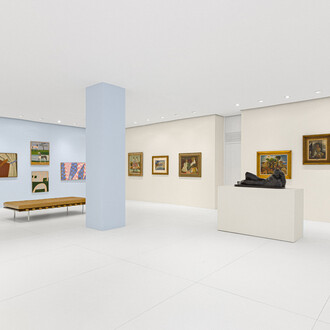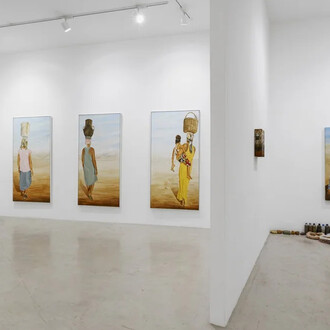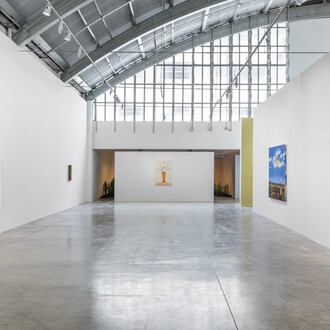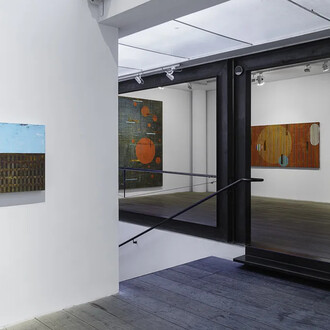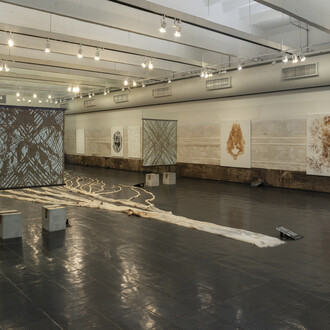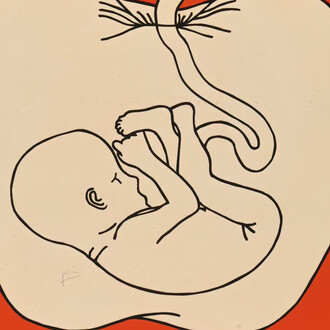The career of Antoni Tàpies (1923-2012) holds a position of enormous relevance within the context of international art during the second half of the twentieth century.
As such, his work is part of those currents in Europe that searched for new ways of expression in the face of the depletion of surrealism, embracing grammars based on the discovery of distinct, more corporal gestures, and on the use of materials until then unfamiliar in the field of painting. On the other hand, also part of a certain European proclivity typical of the seventies, Tàpies developed an increasingly growing interest in non-Western cultures, especially in Chinese and Japanese poetry, thought and art.
In another sense, especially regarding the American scene and as of the fifties, the work of the Barcelona-born artist is considered a counterpoint to American Abstract Expressionism, a cry of protest in the face of the political and cultural asphyxiation of Civil War Spain and the years that follow.
In light of this, we could say that Tàpies takes over the mantle from the two guiding figures of Spanish art: Pablo Picasso and Joan Miró. These two “masters” of the avantgarde who symbolize, respectively and schematically, Picasso’s irreverent tradition in the face of totalitarianism, as well as the erotic drive of his paintings, but also following the example of Miró as the defiant conscience of the Catalan people.
These last traits synthesize one of the aspects that most characterize Tàpies’ work: his ideological, esthetic and social commitment. It can be said that Tàpies belongs to those generations of intellectuals, many of them of bourgeois origin, who in Germany, France or Italy tried to create different public spheres in the face of the dictatorships or police states of postwar Europe.
From the Frankfurt School to the May ’68 events in France, from the Potere Operaio to the Prague Spring, the backdrop of the sixties and seventies exerted a fundamental influence in Tàpies’ career. During these years, he not only took advantage of his influence in worldwide artistic forums to carry out various works that denounced the lack of freedom, the censorship and the political repression under General Franco’s dictatorship, but also engaged in incessant – and at times excessive – public action by means of journalistic writings, theoretical essays and various controversies that turned him into the paradigm of resistance in Catalonia.
In a way, Tàpies represents this international solidarity of the left wing, the scholars and middle class, which was born out of the trauma of Nazism and spread intermittently throughout Europe and South America during the entire Cold War.
This renewal of the social pact project finds its echo in a type of painting that jumps from the subjectivities to the dedication to portraying the back end of the world, as if a single painting could contain beauty, political fracture, existential emotion and be a map for the current moment.
The potency of Tàpies’ work is to be found in the journey it offers us, in its passage from the apocalypse to the apotheosis and back. There is no nihilism in his canvases, objects or sculptures. It is quite the opposite, there is an invitation, at times subtle and at other times arid, to reconnect with the world, to disturb the order established at our expense and through our sacrifice.
Tàpies aspires, certainly without making it explicit, to a type of humanism that is no longer settled between the Apollonian and the Dionysian, between reason and dream, between poetry and ideology. A detectable humanism in the most modest, even the most miserable, elements; in the most unspeakable desires; in a martyr’s flesh; in the wings of angels; and in the pot where workers boil their food.
In times such as these, when complexity seems to be in full process of being erased, when discord and utopia are being pursued under the banner of common sense, Tàpies’ work turns out to be more important and necessary today than ever before. Important because it pushes us to re-imagine the value of art and the meaning of words. It also helps us to see what a defining act opposition to a consensus can be. It is necessary because the place where apparently unchanging dogmas are created is also where the harshness of reality palpitates.
The exhibition at Bergamin & Gomide contains absolutely emblematic works from the 1970’s to the early 2000’s. Some of them have not been shown much in exhibitions; other works illustrate to perfection certain key ruptures in Antoni Tàpies’ career.
Seen as a whole, it is a collection or an anthology that covers all of the artist’s most important periods, whether in the form of sculptures, canvases, installations or works on paper. Likewise, here are all of his favorite media: varnish, marble dust, foam, wood…
It has been said that every painting by Tàpies is an anthology of previous paintings and works to come, that in each canvas the painter narrates a past and future “life”. This exhibition has something of an artistic epic poem and of a political and personal biography.
(Valentin Roma)







![Bruno Munari (1907-1998)
Forchetta parlante, 1958-1991, Ed. 18/20
Garfo torcido sobre madeira
[Bent fork on wood]
15 x 7 x 3 cm [5 7/8 x 2 3/4 x 1 1/8 in.]](http://media.meer.com/attachments/582ae4ad2069da3df8b04376669e19755ef38c25/store/fill/330/330/fddfcc2bc266d3812450a83789a0c87812d6adba2c5fe72080b1c3b22654/Bruno-Munari-1907-1998-Forchetta-parlante-1958-1991-Ed-18-slash-20-Garfo-torcido-sobre-madeira.jpg)
![Bruce Conner (1933-2008)
BREAKAWAY, 1966
Filme 16mm em preto e branco
[Black and white 16mm film]
5 min
BC-0019
Courtesy: The Conner Family Trust, Kohn Gallery and Bergamin & Gomide](http://media.meer.com/attachments/7d07aa708db7f25e05333b5b262166f49883bfa7/store/fill/330/330/839c49e290870e0a9fe994df5e0c140d163ec7ca78a6019e5e8b269855f1/Bruce-Conner-1933-2008-BREAKAWAY-1966-Filme-16mm-em-preto-e-branco-Black-and-white-16mm-film-5.jpg)
